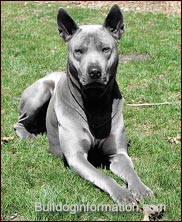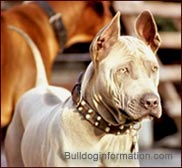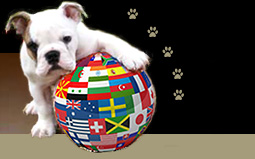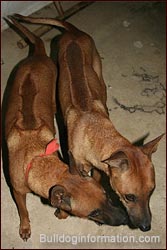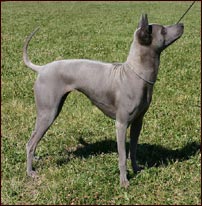One of the three only ridgebacked breeds in the world, the Thai Ridgeback is a multi-purpose dog with a striking appearance and cat-like agility. It was originally employed by Thai peasant owners to protect their homes while they are at work.
Origin
The Thai Ridgeback originated in the eastern part of Thailand and has been used by Thai peasants as a property guards, hunting companions and cart escorts. Archeological documents which were written about 360 years ago already mentioned this breed.
a blue Thai Ridgeback
"Meeko"
Photo by Brian J. Orr
The Thai Ridgeback has remained virtually unknown to the outside world until 1975 and as a consequence the breed's gene pool remained largely undiluted. It was a tradition never to cross a dog with non-Ridgebacks, which explains how the breed could be preserved over the centuries. Some claim it is the Thai Ridgeback which gave rise to the Rhodesian Ridgeback, but it is entirely possible that the ridge pattern occurred spontaneously in two widely remote parts of the world.
Thai ridgeback "Nero"
Photo courtesy of Strawansky
Thai ridgeback "Mawgli"
Photo by Strawansky
Appearance
One of the hallmarks of the breed it the ridge all over the back. The ridge must extend from the shoulders all along the back and be symmetrical, i.e. form a mirror image along the spine. Eight different patterns in the shape of the ridge have been identified: needle, feather, arrow, lute, violin, bowling pin, leaf, and saddleback.
Some sources consider the leaf and saddle as one and the same pattern, but have an additional pattern known as Hu-kra-tai ridge, a pattern resembling a 'sitting rabbit' with its ears apart, formed by two oval shaped patches growing on each side of the backbone.
Eight different possible patterns for the ridge.
The first kennel clubs to register the breed were the Dog Association of Thailand, the Japanese Kennel Club, and the Asian Kennel Union. The breed was recognized by the Federation Cynologique Internationale in 1993. As of January 1st 2008 the Thai Ridgeback is also eligible to participate in American Kennel Club companion and performance events.
Except for two ridge patterns, the needle and feather pattern, all ridge patterns also have crowns, a swirl of hair of the same color as the coat. The largest ridge pattern is called the "Bai Pho" and looks like a huge Bhodi tree leave that covers most of the dogs back as well as part of his hips. The bigger the ridge is, the more valuable the dog is and the higher its market price too.
Thai Ridgeback
(Mah Thai Lang Aan, Royal Dog of Thailand)
.
.
.
.
Original idea, design and development by C. Marien-de Luca. Photos of the Dog Breeds of the World sphere of flags by Mark Stay.
No part of canininformationlibrary.com may be copied, distributed, printed or reproduced on another website without the owner's written permission.
Red Thai Ridgeback
"Blackie", TTAG, Thailand
Photo by slugamore
a blue Thai Ridgeback
Photo by Deanna
Arrow (left) and Feather (right) ridge patterns
Photo courtesy of Mistifarang
The shape of a dog's ridge is also determined by the coat color. Blue dogs usually have smaller ridges as compared to red dogs. As a consequence, a blue dog carrying a big ridge is highly appreciated by Thai dog lovers. The ridges most often seen in the blue color are the lute and arrow ridges.
Any length of hair in the ridge is acceptable but it must be symmetrical along the back bone.
Thai people describe the Thai ridgeback as Kon San (short coat), Lung Ahn (ridgeback), Hoo Tang (erect ears), and Hang Dab (tail up like a sword). These terms refer to a drawing of an Thai ridgeback supposedly found in a 350 year-old book.
The coat should be very dense and the color always solid.
Thai ridgebacks come in four different coat colors: red (light chestnut), fawn (from almost white over silver to light fawn), black or blue. The coat should be very dense and the color always solid. White markings on chest and paws permitted. A black mask in reds is preferable and black markings on the tongue are greatly desirable.
The four main coat colors of the Thai ridgeback: red, blue, fawn, black
The coat can be of three different lengths or textures: long, short or velvet. In a long coat the hair should not be longer than 1 inch (2.5cm). The short coat was very popular in the past, but with the appearance of the first velvet coats, the latter became increasingly popular. The velvet coat gives the dog a very striking appearance with a very short and fine coat appearing to be part of the skin. However, the short coat remains popular among a lot of breeders because it is much easier to maintain and offers a better protection against colder climates. The ridge is also more visible against a short background.
The eye color should match the coat color, in blue and fawn dogs amber colored eyes are permitted, but in the other colors the eyes should be dark brown. The nose should be black and dark markings on the tongue is characteristic for the breed.
The tail is another important trait of the breed: it should be carried slightly curved and well set-up. Ears are pointed and erect.
Weight: 50-75 pounds (23-34 kg). Height: 22-26 inches (56-66cm)
Temperament
The Thai Ridgeback is a primitive breed and as with other primitive dogs, traditional training methods often fail to give the expected results. Especially training methods based on play do not easily catch the Thai Ridgeback's attention, but food and treats are appreciated and can be used as rewards in training exercises based on positive reinforcement.
They are a proud, powerful and independent breed that may become aggressive in the wrong hands. While the Thai Ridgeback is extremely fierce as a home guardian, once off the property it is not nearly as "attack-oriented". They are tough and active, and present excellent jumping ability.
Aggressiveness or extreme shyness are considered severe faults.


